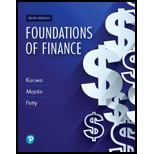
EBK FOUNDATIONS OF FINANCE
10th Edition
ISBN: 9780135160473
Author: KEOWN
Publisher: PEARSON CO
expand_more
expand_more
format_list_bulleted
Concept explainers
Textbook Question
Chapter 7, Problem 5SP
(
- a. What did you pay for the bond?
- b. If you sold the bond at the end of the year, what would be your one-period
return on the investment ?
Expert Solution & Answer
Want to see the full answer?
Check out a sample textbook solution
Students have asked these similar questions
You are given the following information concerning four stocks:
Using 20X0 as the base year, construct three aggregate measures of the market that simulate the Dow Jones Industrial Average, the S&P 500 stock index, and the Value Line stock index (i.e., a simple average, a value-weighted average, and a geometric average).
a. What is the percentage change in each aggregate market measure from 20X0 to 20X1, and 20X0 to 20X2? Why are the results different even though only one stock’s price changed and in each case the price that changed doubled?
b. If you were managing funds and wanted a source to compare your results, which market measure would you prefer to use in 20X2?
*Show all work & necessary formula(s)
7. If the inflation rate is 3% and the nominal return on an investment is 8%, what is the real return approximately?
A) 5.0%B) 4.9%C) 5.2%D) 6.0%
7. If the inflation rate is 3% and the nominal return on an investment is 8%, what is the real return approximately?
A) 5.0%B) 4.9%C) 5.2%D) 6.0%need help properly.
Chapter 7 Solutions
EBK FOUNDATIONS OF FINANCE
Ch. 7 - Prob. 1RQCh. 7 - Prob. 2RQCh. 7 - Prob. 3RQCh. 7 - a. How does a bonds par value differ from its...Ch. 7 - Prob. 5RQCh. 7 - Prob. 6RQCh. 7 - Prob. 7RQCh. 7 - Prob. 8RQCh. 7 - Prob. 9RQCh. 7 - Define the expected rate of return to bondholders.
Ch. 7 - (Bond valuation) Bellingham bonds have an annual...Ch. 7 - (Bond valuation) Flora Co.s bonds, maturing in 7...Ch. 7 - (Bond valuation) You own a 20-year, 1,000 par...Ch. 7 - (Bond valuation) Calculate the value of a bond...Ch. 7 - (Bond valuation) At the beginning of the year, you...Ch. 7 - Prob. 6SPCh. 7 - (Bond relationship) Mason, Inc. has two bond...Ch. 7 - Prob. 8SPCh. 7 - (Bond valuation) National Steels 15-year, 1,000...Ch. 7 - (Bond valuation) You own a bond that pays 70 in...Ch. 7 - Prob. 11SPCh. 7 - (Bond valuationzero coupon) The Latham Corporation...Ch. 7 - (Bond valuation) Bank of America has bonds that...Ch. 7 - Prob. 15SPCh. 7 - Prob. 16SPCh. 7 - Prob. 17SPCh. 7 - (Bondholders expected rate of return) You own a...Ch. 7 - (Expected rate of return and current yield) Time...Ch. 7 - (Expected rate of return and current yield)...Ch. 7 - Prob. 21SPCh. 7 - Prob. 22SPCh. 7 - (Current yield) Assume you have a bond with a...Ch. 7 - Prob. 24SPCh. 7 - (Expected rate of return) Assume you own a bond...Ch. 7 - Prob. 26SPCh. 7 - (Bondholders expected rate of return) You...Ch. 7 - Prob. 1MCCh. 7 - Assume that the bonds are selling for the...Ch. 7 - Prob. 3MCCh. 7 - Prob. 4MCCh. 7 - Prob. 5MC
Knowledge Booster
Learn more about
Need a deep-dive on the concept behind this application? Look no further. Learn more about this topic, finance and related others by exploring similar questions and additional content below.Similar questions
- Which of the following formulas represents compound interest? A) I = PRTB) A = P(1 + rt)C) A = P(1 + r/n)^(nt)D) A = P - Ineed help!arrow_forwardWhich of the following formulas represents compound interest? A) I = PRTB) A = P(1 + rt)C) A = P(1 + r/n)^(nt)D) A = P - Iarrow_forwardA bond pays annual coupons of $60 and is currently priced at $1,050. What is its current yield? A) 6.0% B) 5.7% C) 5.5% D) 5.0% explainarrow_forward
- 8. A bond pays annual coupons of $60 and is currently priced at $1,050. What is its current yield? A) 6.0%B) 5.7%C) 5.5%D) 5.0% helparrow_forward8. A bond pays annual coupons of $60 and is currently priced at $1,050. What is its current yield? A) 6.0%B) 5.7%C) 5.5%D) 5.0%arrow_forwardWhat is the effective annual rate (EAR) if the nominal rate is 12% compounded quarterly? A) 12.55%B) 12.00%C) 12.36%D) 12.82% need help!arrow_forward
- What is the effective annual rate (EAR) if the nominal rate is 12% compounded quarterly? A) 12.55%B) 12.00%C) 12.36%D) 12.82%arrow_forwardA loan of $10,000 is to be repaid in equal annual installments over 4 years at 5% interest. What is the annual installment? A) $2,564.57B) $2,856.44C) $2,312.49D) $2,775.60arrow_forward1. What is the simple interest on a loan of $5,000 at 6% per annum for 3 years? A) $900B) $750C) $1,200D) $600arrow_forward
- What is the monthly payment on a $12,000 loan at 6% annual interest, to be repaid over 1 year? A) $1,030.33B) $1,033.00C) $1,035.45D) $1,050.00need help!!arrow_forwardWhat is the monthly payment on a $12,000 loan at 6% annual interest, to be repaid over 1 year? A) $1,030.33B) $1,033.00C) $1,035.45D) $1,050.00arrow_forward4. A stock pays an annual dividend of $3 and is currently priced at $60. What is the dividend yield? A) 4%B) 5%C) 6%D) 3%arrow_forward
arrow_back_ios
SEE MORE QUESTIONS
arrow_forward_ios
Recommended textbooks for you
 EBK CONTEMPORARY FINANCIAL MANAGEMENTFinanceISBN:9781337514835Author:MOYERPublisher:CENGAGE LEARNING - CONSIGNMENT
EBK CONTEMPORARY FINANCIAL MANAGEMENTFinanceISBN:9781337514835Author:MOYERPublisher:CENGAGE LEARNING - CONSIGNMENT Intermediate Financial Management (MindTap Course...FinanceISBN:9781337395083Author:Eugene F. Brigham, Phillip R. DavesPublisher:Cengage Learning
Intermediate Financial Management (MindTap Course...FinanceISBN:9781337395083Author:Eugene F. Brigham, Phillip R. DavesPublisher:Cengage Learning

EBK CONTEMPORARY FINANCIAL MANAGEMENT
Finance
ISBN:9781337514835
Author:MOYER
Publisher:CENGAGE LEARNING - CONSIGNMENT

Intermediate Financial Management (MindTap Course...
Finance
ISBN:9781337395083
Author:Eugene F. Brigham, Phillip R. Daves
Publisher:Cengage Learning
Bond Valuation - A Quick Review; Author: Pat Obi;https://www.youtube.com/watch?v=xDWTPmqcWW4;License: Standard Youtube License